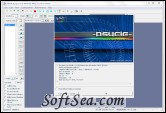|
Psycle 
|
Psycle is a Music tracker (like FastTracker 2 or Impulse Tracker) combined with plugin modularity. It supports its own plugin API, the VST2 plugin standard, and a tracker style sampler playback. Psycle Modular Music Creation Studio is a music creation studio to help you with your work. Psycle is a free, Open-Source, music creation program that offers an easy way to create your own music, fast, and with high quality.
Psycle uses a classical tracker interface (a text grid of notes which are sequenced one after the other), coupled with modularity (plugins) that allow to extend the sounds that you get from it.
It supports three ways to get sound: its own native format, the VST Plugin standard, and recorded .wav samples using the sampler machine.
Notes are entered in patterns, where you can also use commands (plugin specific, or global), as well as automating parameters via the mcm and twk commands. These patterns are then organized in a linear sequence, which becomes the song order.
Psycle Modular Music Creation Studio Features:
1. A 64 Tracks Pattern Editor, with up to 1024 lines.
2. 256 sequence positions.
3. Audio Routing (machine) view to interconnect the virtual machines in order to apply different effects.
4. Internal Stereo Sampler unit which supports .wav and .iff files of any sampling rate, 8/16 and 24bits, mono or stereo.
5. 70+ Native Plugins (generators & effects), most of them open-source and with an easy to use API to create new ones.
6. Support for VST1 and VST2 plugin standard.
7. Importing of .xm's/.s3m's/.it's/.mod's.
8. Exporting to wav, as well as recording realtime to .wav
9. Configurable Keyboard Layout
10. Midi-In Support ( control Psycle using a midi keyboard, or even a software sequencer)
11. Themes and skins support and much more.
Before you can enter any melodies, percussion or other notes, you have to set up Psycle to play or create your sounds. Here is where the first of the two main concepts of Psycle come in: Using Psycle is like using all those old hardware synths, which you would connect via cables to effects boxes, which would then be connected to your amplifier and then your speakers - the only difference here is that it's all virtual.
In Psycle, these virtual synths and effects are called machines, which are broken into two types: Generators and Effects. Generators create the sounds, and effects modify them. You will see them represented with boxes like the ones below (they can be changed by Skinning). The Master machine (the first one you see when you start up Psycle) is your virtual mixer. (Later on, you'll find that there is another mixer machine )
Most of the Psycle machines are plugins, which means you can add new ones besides those that come with Psycle. There are three categories: Internal, Native and VSTs. Internal machines are built into Psycle, Native plugins are designed specifically for psycle, and VST is a standard by Steinberg to create virtual synthesys (have a look at www.kvr-vst.com - there are many out there!).
Now, your sound might be a bit plain and boring at the moment, but there's plenty of work to be done yet. Firstly, we can change the parameters of the synthesiser. To do this, double click on a non-active part of your generator. This brings up a window where you can edit the individual parameters of the machine.
Another type of generator is the Psycle Internal Sampler, which allows you to use .wav and .iff samples in your songs. First, open the "Add Machine" window, and in the "Generators" section, select "Sampler" and click OK. Connect the sampler machine to the master machine.
Now that you've got your sounds working, it's time to enter some notes to make a proper song. To open the pattern window, press F3 OR go to the menu View > Pattern Editor. A Psycle song consists of patterns which are then sequenced. A pattern is made up of rows and tracks.
Each row corresponds to a time interval. With the default Line-per-beat setting of 4, that means that every row corresponds to a dem-semi-quaver, or 16th-note. However, this does not mean that a note is restricted to a 16th-note duration - that depends on the settings of the generator and Note-Off commands. It is analogous to having a piano score with every note and rest written out as tied 16th notes (or whatever time interval applies).
By now you should know how to make a simple song. But what about automating parameter changes? (just think of those filter sweeps you've heard in commercial tracks). This is where the "Tweak" and "Tweak Smooth" commands come in.
The license of this software is Free, you can free download and free use this audio utility software.
